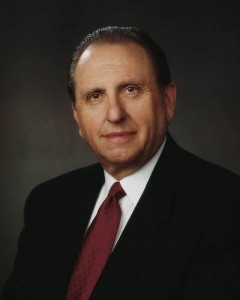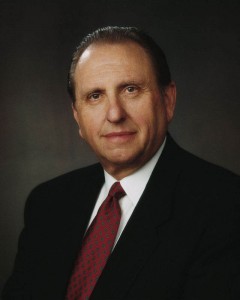Thomas Spencer Monson
Thomas Spencer Monson became Prophet and President of The Church of Jesus Christ of Latter-day Saints (which church is frequently misnamed the Mormon Church) on February 3, 2008, after the death of Gordon B. Hinckley.
Early Life
Thomas Monson was born on August 21, 1927, in Salt Lake City, Utah, to G. Spencer and Gladys Condie Monson. The second of six children, he grew up in a tight-knit Mormon family. In fact, many of his mother’s relatives lived on the same street, and the extended families frequently went on trips together. Young Monson loved to swim and fish, and once, during a family outing to the Provo River in Provo, Utah, Monson rescued a girl from drowning. Though his family was not wealthy, and Monson later recalled that their home, while comfortable, was drafty, the Monson family was nevertheless known for their generosity. On several occasions, young Monson gave away animals that he had raised to other, more needy families.
 In the spring of 1945, at age 17, Monson joined the United States Naval Reserves and anticipated participating in World War II in the Pacific theater. Instead, Germany capitulated within weeks of his joining, and the war in the Pacific ended within months. His tour of duty lasted only six months after the end of the war and, upon its completion, he enrolled at the University of Utah. Monson graduated cum laude in 1948 with a bachelor’s degree in Business Management.
In the spring of 1945, at age 17, Monson joined the United States Naval Reserves and anticipated participating in World War II in the Pacific theater. Instead, Germany capitulated within weeks of his joining, and the war in the Pacific ended within months. His tour of duty lasted only six months after the end of the war and, upon its completion, he enrolled at the University of Utah. Monson graduated cum laude in 1948 with a bachelor’s degree in Business Management.
Thomas Monson taught for a time at the University of Utah, and then began his career in publishing. His first job was with the Deseret News, where he became an advertising executive with the Newspaper Agency Corporation. That same year, he met and married Frances Beverly Johnson. Their marriage was solemnized in the Salt Lake Temple of the “Mormon Church” on October 7, 1948. The couple has three children: Thomas Lee, Ann Frances, and Clark Spencer. They have eight grandchildren and seven great-grandchildren.
Later, Monson transferred to the Desert News Press, one of the largest presses in the Western United States. He began as a sales manager and eventually became general manager. He continued his education and received his Masters in Business Administration from the Mormon Church-owned Brigham Young University in 1952. He accomplished all this before the age of 32.
In addition to these work and family responsibilities, Monson also became a Mormon bishop at age 22, one of the youngest men ever called to that position. As a bishop in Salt Lake City, he presided over a Latter-day Saint congregation of over 1,000 people, including 86 widows. Early on, Monson was recognized for his leadership and organizational skills and his concern for the downtrodden and humble. He visited those 86 widows regularly and, even after leaving the position, he continued to visit them each Christmas for the rest of their lives, bringing them gifts (often poultry he raised himself) and chatting with them. He spoke at nearly every one of their funerals. There were also many poor people living within the boundaries of this ward, and Monson took special care to help them as he could. Even today, he continues to visit former members of this ward and regularly visits nursing homes in Salt Lake City to attend to the elderly, especially those who have no one else to visit them.
Call to the Apostleship
At age 27, he became a counselor to a stake president in Salt Lake City, and became a mission president at age 32. As mission president, he presided over the Canadian Mission from 1959 to 1962, supervising Mormon missionaries who were not much younger than he was. Upon his return, he resumed his work with the Deseret News until he was called to be an apostle in The Church of Jesus Christ of Latter-day Saints in 1963 at age 36, the youngest apostle since 1910.
As an Apostle, Thomas Monson has worked in many areas of the world and in many capacities for the “Mormon Church.” With his business background, he has helped to oversee many operations of the Church, including KSL and Bonneville Communications. He was chair of the Scriptures Publication Committee in the 1970s. This committee oversaw publication of the Mormon edition of the King James Version of the Bible and revised editions of Mormon scriptures, like the Book of Mormon. These new editions, while they did not change scriptural content, contained extensive footnotes, cross-references, and guides. He has also overseen the Printing Advisory Committee, the Missionary Executive Committee (which oversees the missionary program of the Church), and the General Welfare Committee. Monson served as First Vice Chairman of the Church Board of Education and Board of Trustees that govern the Church Educational System.
Thomas S. Monson has also been instrumental in the growth of Mormonism in Europe. For a time, he oversaw Church operations in Eastern Europe. His friendly and open manner gained access for the “Mormon Church” to its members in the Soviet Block. In 1982, he organized the first stake in Soviet-controlled territory, specifically in East Germany. He was instrumental in obtaining permission to build a Mormon temple in Freiberg, East Germany, in 1985.
Despite these duties, Thomas S. Monson has continued to be active in community and civic affairs. He is past president of the Printing Industry of Utah and former board member of the Printing Industry of America. Since 1969, he has served on the National Executive Board of the Boy Scouts of America, from whom he has received the Silver Beaver (1971), the Silver Buffalo (1978) which is the highest honor bestowed by the BSA, and, in 1993, the Bronze Wolf, the highest honor bestowed by the international Scouting movement. He received the Distinguished Alumnus award from the University of Utah in 1966 and later served on the Utah State Board of Regents. In December of 1981, President Ronald Reagan appointed Monson to the President’s Task Force for Private Sector Initiatives. He remained with the initiative until it completed its work in December of 1982.
Following the death of Church President Spencer W. Kimball in 1985, Monson was chosen as Second Counselor in the First Presidency by new Church President Ezra Taft Benson. He was 58, the youngest Counselor since 1901. After serving in this position under Benson and Howard W. Hunter, he was named First Counselor to President Gordon B. Hinckley in 1995. He simultaneously became President of the Quorum of the Twelve Apostles by seniority.
Thomas S. Monson, affectionately called “Tommy Monson” by his elders, is known for his photographic memory and his ability to quote scriptures extensively without assistance. He once was called upon to visit members of the Church in East Germany. It was felt that the membership there needed a manual explaining the administration of church duties, but that such a manual might be confiscated by East German authorities. Elder Monson memorized the entire manual. As he sat down to dictate it from memory to church leaders in East Germany, he noticed that there was a copy of the manual on the office shelf.
His talks are considered unique and poetic and his delivery style exceptional. He frequently quotes poetry and shares stories about the many people he has known over the years, relating how the gospel of Jesus Christ has helped them in their lives. He is known for his extensive use of alliteration and the passive voice. He often speaks about his childhood experiences, as well as the influence people can have on one another.
Twitter •


 Watch a video about the restoration of the gospel on lds.org
Watch a video about the restoration of the gospel on lds.org